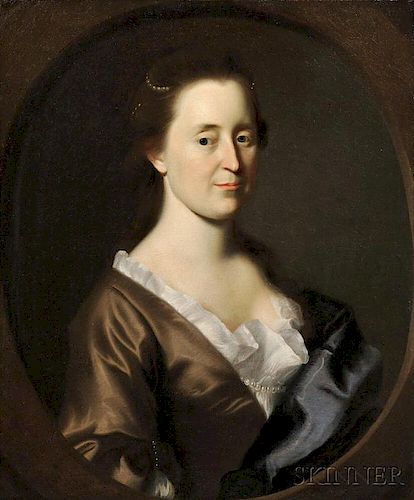John Singleton Copley (American, 1737-1815) Portrait of Rebecca Dudley Gerrish
Lot 370
About Seller
Bonhams Skinner
274 Cedar Hill Street
Marlborough, MA 01752
United States
Founded over four decades ago, Bonhams Skinner offers more than 60 auctions annually. Bonhams Skinner auctions reach an international audience and showcase the unique, rare, and beautiful in dozens of categories, including the fine and decorative arts, jewelry, modern design, musical instruments, sc...Read more
Categories
Estimate:
$150,000 - $200,000
Absentee vs Live bid
Two ways to bid:
- Leave a max absentee bid and the platform will bid on your behalf up to your maximum bid during the live auction.
- Bid live during the auction and your bids will be submitted real-time to the auctioneer.
Bid Increments
| Price | Bid Increment |
|---|---|
| $0 | $10 |
| $100 | $25 |
| $500 | $50 |
| $1,000 | $100 |
| $3,000 | $250 |
| $5,000 | $500 |
| $10,000 | $1,000 |
| $30,000 | $2,500 |
| $50,000 | $5,000 |
| $100,000 | $10,000 |
| $300,000 | $25,000 |
| $500,000 | $50,000 |
| $1,000,000 | $100,000 |
About Auction
By Bonhams Skinner
Jan 23, 2015 - Jan 24, 2015
Set Reminder
2015-01-23 16:00:00
2015-01-24 16:00:00
America/New_York
Bidsquare
Bidsquare : American & European Paintings & Sculpture
https://www.bidsquare.com/auctions/skinner/american-european-paintings-sculpture-405
Bonhams Skinner bidsquare@bonhamsskinner.com
Bonhams Skinner bidsquare@bonhamsskinner.com
- Lot Description
John Singleton Copley (American, 1737-1815)
Portrait of Rebecca Dudley Gerrish, c. 1763-66
Unsigned, identified on loan labels from the Museum of Fine Arts, Boston, affixed to
the frame backing.
Oil on canvas, 30 x 25 in. (76.0 x 63.4 cm), framed.
Condition: Lined, scattered retouch, craquelure.
Provenance: Direct descent from the sitter to her great-niece, Mrs. Henry Bradlee (Hephsibah Hall, b. 1821), by 1893; to her son-in-law Edward N. Fenno; to his daughter Mrs. Arthrur W. Bell by 1950; to her cousin John Brooks Fenno; through to the current owner by family descent.
N.B. The portrait is accompanied by an expert opinion written by Theodore E. Stebbins, Jr., dated July 24, 2013, confirming the attribution to John Singleton Copley and suggesting the date of the mid-1760s, when, through various commissions, Copley painted a small group of portraits of mature, handsome women in Boston. Dr. Stebbins writes that the Gerrishes were well-known patrons of Copley. The portrait of Rebecca Dudley Gerrish is clearly a pendant to one of her husband, Benjamin Gerrish, painted probably five years after hers. The Benjamin Gerrish portrait descended in the Gerrish family and was listed and reproduced in the work of several Copley scholars, including the catalogue raisonné of the artist (Jules Prown, 1966, no 313). Mrs. Gerrish's portrait, which descended in the Dudley line, had not been seen by mid-20th century scholars, but was listed in Prown's catalogue raisonné among the attributed pictures, based on its mention in a 1913 history of the family of Captain John Gerrish by Arthur Eaton.
John Singleton Copley is one of the most beloved American artists. Largely self taught, Copley was a sought-after portrait painter among the elite in colonial Boston. He painted likenesses with objective accuracy and powerful insight. He could masterfully convey every detail of his sitter's costume, making palpable the sheen of satin, the delicacy of lace, the richness of damask and pearls, and capturing subtle reflections in highly polished wood. More importantly Copley used these elements to reinforce the sense of the sitter's character. The combined effect was such that John Adams wrote of Copley's portraits "...you can scarcely help discoursing with them, asking questions and receiving answers." (1)
However, a man of ambition and intellect, Copley was not content to remain a provincial portrait painter. Portraiture, while lucrative, in his view lay closer to craft than high art. Nor did he feel that colonial Americans had great appreciation for the fine arts. Copley aspired to the eleveated role of History Painter, and in Europe he saw the opportunity to learn from the Old Masters and to broaden his subject matter for more sophisticated audiences. Copley left Boston for England in 1774 to pursue his career (and, some say, to avoid the instability of the political situation). He found continued success abroad, and he never returned to America.
1, Virgil Barker, American Painting, History and Interpretation (New York:
Macmillan, 1950), p. 134.
Estimate $150,000-200,000
Wax lined. Retouch to fill craquelure in the face and neck, with one larger spot on the sitter's chest measuring 1 inch diameter and located just above the ruffle of her garment. Retouch more concentrated in the lower spandrels, with a horizontal line measuring about 10 inches overall, located l.c. and l.r. General area of retouch to l.l. spandrel. An area of retouch to u.l. quadrant measuring about 4 x 1 inches and located 6 1/2 inches down and 4 1/2 inches in from the upper left corner.
Labels on the frame backing indicate that the work was on loan to the Museum of Fine Arts, Boston, from 1980 to 1991.
The absence of a condition statement does not imply that the lot is in perfect condition or completely free from wear and tear, imperfections or the effects of aging. Condition requests can be obtained via email (lot inquiry button) or by telephone to the appropriate gallery location (Boston/617.350.5400 or Marlborough/508.970.3000). Any condition statement given, as a courtesy to a client, is only an opinion and should not be treated as a statement of fact. Skinner Inc. shall have no responsibility for any error or omission. - Shipping Info
-
Please visit http://www.skinnerinc.com/services/payment-and-shipping/ for information regarding the collection of items purchased at auction.
-
- Buyer's Premium



 EUR
EUR CAD
CAD AUD
AUD GBP
GBP MXN
MXN HKD
HKD CNY
CNY MYR
MYR SEK
SEK SGD
SGD CHF
CHF THB
THB




















